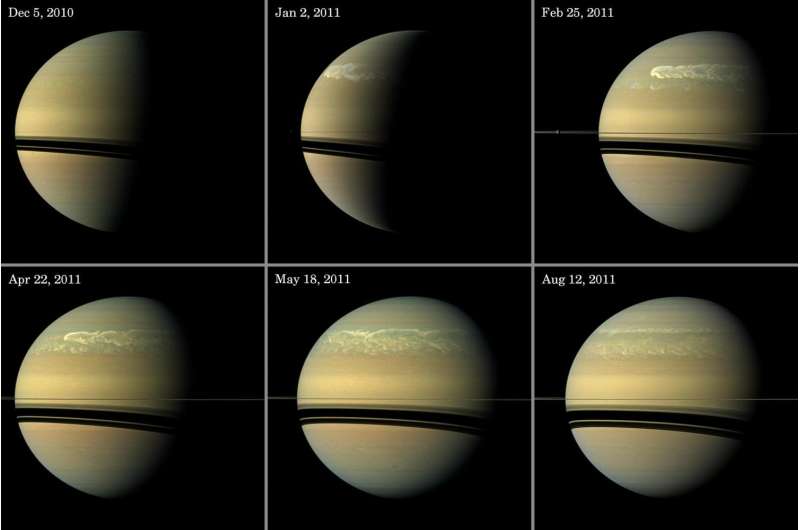August 5, 2016 report
Scientists study the evolution of Saturn's great storm of 2010-2011

(Phys.org)—The NASA/ESA Cassini spacecraft has made plenty of groundbreaking discoveries, outstandingly improving our knowledge of Saturn and its moons, including our understanding of violent processes in the atmosphere of our solar system's second-largest planet. Now, a new research paper published July 26 on arXiv.org, which details the dynamics and evolution of Saturn's great storm of 2010-2011, marks another important study based on the data provided by Cassini's scientific instruments.
Saturn experiences quasi-periodic planet-encircling storms. The latest significant, well-observed storm started on Dec. 5, 2010 and lasted until the end of 2011. Events like storms can be identified visually and through radio noise; thus, instruments onboard Cassini such as the Cassini Imaging Science Subsystem (ISS) and the Radio and Plasma Wave Science (RPWS), allowed scientists to obtain high-precision measurements of these violent outbursts in the planet's atmosphere.
Recently, a team of researchers led by Kunio Sayanagi of Hampton University in Virginia, analyzed the data provided by ISS and RPWS to study the storm's birth, evolution, and demise. ISS obtained wide-angle pictures of the storm with a resolution of 60 to 120 km per pixel to study the vertical cloud structure. The instrument also allowed the team to measure cloud motions in order to reveal the atmospheric dynamics of the storm region. RPWS provided crucial information about the configuration of Saturn's magnetic field, ionosphere, plasma, and lightning from the planet's atmosphere.
"We analyze Cassini ISS images and RPWS data to investigate the temporal evolution of the 2010-2011 planet-encircling storm. (…) Our study analyzes images acquired using the wide-angle camera's CB2 (750 nm), MT2 (727 nm), and MT3 (889 nm) filters to study the vertical cloud structure. (…) We also present analysis of RPWS data that shows near-simultaneous coverage of the end of the convecting phase of the storm," the scientists wrote in the paper.
According to the research, the storm erupted out of a previously known feature called the String of Pearls (SoPs)—a chain of about 26 cyclones located at 33° N planetocentric latitude. Afterwards, the outburst grew and engulfed the entire latitude zone. The scientists noted that on January 11, 2011, the dimensions of the storm's "head" were 9,200 km and up to 34,000 km in the north-south and east-west dimensions, respectively. They also emphasized that this storm spawned the largest tropospheric vortex ever seen on Saturn.
"On January 11, 2011, the anticyclone was sized 11,000 km by 12,000 km in the north-south and east-west directions, respectively. (…) With the east-west diameter of 12,000 km, the new anticyclonic vortex became greater in size than any tropospheric vortex previously seen on Saturn. The rapid growth and shrinkage of the new anticyclone is in stark contrast to the steadiness of anticyclonic vortices on Jupiter," the paper reads.
The study notes major changes in the storm dynamics after June 20, 2011 when the storm's head collided with the anticyclone after the anticyclone's longitude trailed 360° longitude behind the core. After this collision, the storm's convective activity displayed a major decline. However, the storm left the region between 25°N and 40°N in a highly disturbed state. According to the paper, these atmospheric events also altered the zonal mean wind profile of the storm latitudes.
The researchers expect that the storm of 2010-2011 will have lasting effects on Saturn's northern hemisphere.
"The aftermath of the latest storm should have an effect that may last for up to a decade, and a continuing monitoring of Saturn from the orbiting vantage point of Cassini spacecraft should reveal further details of the dynamic event," the scientists concluded.
More information: — Kunio M. Sayanagi et al. Dynamics of Saturn's great storm of 2010–2011 from Cassini ISS and RPWS, Icarus (2013). DOI: 10.1016/j.icarus.2012.12.013
— Dynamics of Saturn's great storm of 2010-2011 from Cassini ISS and RPWS, arXiv:1607.07246 [astro-ph.EP] arxiv.org/abs/1607.07246
Abstract
Saturn's quasi-periodic planet-encircling storms are the largest convecting outbursts in the Solar System. The last eruption was in 1990. A new eruption started in December 2010 and presented the first-ever opportunity to observe such episodic storms from a spacecraft in orbit around Saturn. Here, we analyze images acquired with the Cassini Imaging Science Subsystem (ISS), which captured the storm's birth, evolution and demise. In studying the end of the convective activity, we also analyze the Saturn Electrostatic Discharge (SED) signals detected by the Radio and Plasma Wave Science (RPWS) instrument.
Journal information: Icarus
© 2016 Phys.org





















